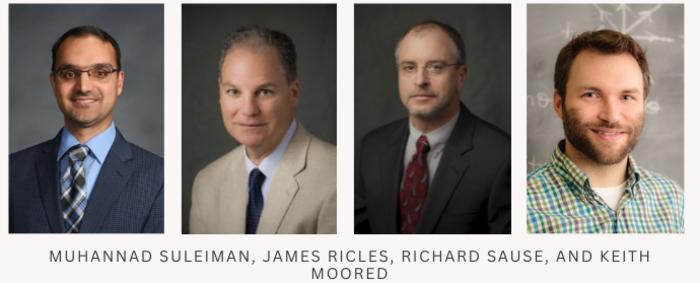In the past few years, we’ve seen a push toward renewable energy. One focus is wind, which is harvested via turbines–you may have seen them in mountainous areas, turning in the wind. But the United States’s most abundant wind potential lies offshore; wind speeds are highest off both coasts. This means offshore wind turbines promise high energy yields, akin to the offshore wind production in the North Sea near northern Europe.

Credit: Institute for Cyber Physical Infrastructure and Energy/Lehigh University
In the past few years, we’ve seen a push toward renewable energy. One focus is wind, which is harvested via turbines–you may have seen them in mountainous areas, turning in the wind. But the United States’s most abundant wind potential lies offshore; wind speeds are highest off both coasts. This means offshore wind turbines promise high energy yields, akin to the offshore wind production in the North Sea near northern Europe.
But constructing wind turbine platforms in water deeper than ~60 meters presents problems. Turbines in shallow waters, like those in the North Sea, can be mounted on fixed-bottom platforms, held to the sea floor by a rigid structure such as a monopile or foundation. The offshore turbines now operating in the U.S. are fixed bottom turbines located in the relatively shallow waters over the Continental shelf near New England. But deeper water, like that along the northeast and the West Coast, which represents two-thirds of US offshore wind resources, renders this type of mount impractical. Engineers are therefore turning to floating offshore platforms and attempting to create economical, innovative floating structures that can harvest wind energy while also capturing energy from wave action.
Floating platforms, which originated with oil and gas drilling, are held in place by mooring lines anchored to the ocean floor in various designs and configurations. And unlike oil and gas platforms, they need to carry the taller, unbalanced load of a wind turbine. So floating wind platforms present their own set of problems, issues that Muhannad Suleiman and his co-investigators at Lehigh University–James Ricles, Richard Sause, and Keith Moored–are working to solve.
Suleiman, Professor of Civil and Environmental Engineering and Deputy Director of the Advanced Technology for Large Structural Systems (ATLSS) Center; Ricles, Bruce G. Johnson Professor of Structural Engineering and Director of the Advanced Technology for Large Structural Systems (ATLSS) Center; Sause, Joseph T. Stuart Professor of Structural Engineering; and Moored, Associate Professor of Mechanical Engineering and Mechanics, have recently received a $1 million National Science Foundation Research Advanced by Interdisciplinary Science and Engineering Clean Energy Technology (NSF RAISE CET) award for a three-year project called “Coupled Aero-Hydro-Geotechnical-Mechanical Interaction and Control of Floating Offshore Wind Turbines Subjected to Extreme Loading Conditions.”
Offshore wind platforms experience extreme forces from just about every direction. The winds that load the turbine can be quite strong, pushing both the turbine blades and the platform; the waves can also cause force against the platform and pull on the mooring lines, which in turn exert a pulling force against the anchors holding them in place. Extreme weather events, such as a hurricane or major storm, can exacerbate all these forces. Suleiman notes that such events “apply significant loads to the structure, including wind and wave loading on the structure.” Wind and waves are also sources of energy. The Lehigh team is trying to combine wind and wave energy generation to make these floating offshore platforms more efficient and resilient.
The efficiency and resilience goals will move in four steps. The first is finding new ways to reduce the platform’s motions. Pitch (up and down) and roll (side-to-side) motions are a focus here as they amplify the movements along the length of the turbine, from sea level to the rotor. Limiting these motions improves the resilience of the structure. This part of the research project will be led by Moored and Sause.
The second is evaluating effects of platform motion reductions on mooring line fatigue response; this part of the project will be led by Sause. After establishing a baseline for platform movement, innovations such as ballast placement and damper systems will be studied for their effects on the platform’s movement.
The third goal involves investigating bio-inspired concepts for energy generation and foundations to improve platform stability and to determine potential increased power output. Oscillating hydrofoils, kinetic devices attached beneath the platform, are modeled according to the movements of aquatic animals, who are masters at navigating unsteady and vortical flows. Bio-inspired anchors will also be analyzed; these rough-surfaced anchors–inspired by snakeskin–increase friction between the foundation and surrounding soil to resist pull-out forces. This facet of the research will be led by Suleiman and Moored.
The fourth goal involves real-time hybrid simulations and is led by Ricles. The data from the previous research tasks–the aero, hydro, geotechnical, and mechanical of the project title–will be used to simulate their combined interactions under extreme loading conditions, allowing the team to address the technical challenges and interactions involved in floating offshore wind energy production. The wind, water and mechanical loads on the turbine, platform, and mooring lines will be analyzed and combined with experimental results on the soil and the foundation to produce “the response of the whole floating offshore wind turbine system which help understand the interaction between different parts (or subsystems) interact,” Suleiman says. This is important, he says, because most of the time, these subsystems are treated separately: a structural engineer will look at the loads on the tower, a mechanical engineer will study the aero and hydrodynamic loads, and so on, but there are few ways to study the entire system as a single operating unit. Bringing all the parts together not only mimics the real interactions of these subsystems, but also allows for a greater understanding and the maximization of their operation and energy output.
The team will use Lehigh University facilities at ATLSS and Suleiman’s soil-foundation-structure interaction facility, as well as the real-time hybrid simulation facility.



